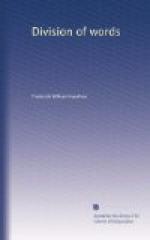A Manual for Writers. By John Matthews Manly and John Arthur Powell. The University of Chicago Press, Chicago.
Worcester’s New Pronouncing Spelling Book. The American Book Company, New York.
The Art of Writing and Speaking the English Language: Dictionary of Errors. By Sherwin Cody. The Old Greek Press, Chicago.
(This is one of a series of six very excellent but inexpensive little books bearing the same general title and by the same author. They will be found very useful in connection with Part VI of the Typographic Technical Series generally.)
QUESTIONS
1. Is the spelling of English standardized?
2. How long have we considered correct spelling important?
3. What two causes exist for difficulties in spelling?
4. What are the principal English authorities?
5. What are the principal American authorities?
6. How are these authorities used in printing offices?
7. What are the rights and duties of the author in the matter of spelling?
8. What may be done in matter of “reformed” spelling?
9. What is a safe attitude for the commercial printer toward “reformed” spelling, and why?
10. On what does correct spelling mainly depend?
11. What is the best way to become a good speller?
12. Why is English difficult to pronounce?
13. What is a diphthong?
14. What is a digraph?
15. What are the two sounds each of c, g, de, th, and s? Give examples of each.
16. How many letters are there in the English alphabet and how many sounds do they express?
17. Upon what does correct pronunciation depend?
18. What is a syllable, and of what does it consist?
19. What peculiar use is made of l and n in English?
20. How do we treat the parts of a diphthong or digraph?
21. How do we know whether or not these compounds are diphthongs or digraphs?
22. What about vowel combinations?
23. With what should a syllable not end?
24. With what should a syllable not begin?
25. What is the rule regarding prefixes and suffixes?
26. How do we treat two or three consonants capable of beginning a syllable?
27. How do we treat two or three consonants capable of ending a syllable?
28. How do we treat doubled consonants?
29. What is accent?
30. Do words ever have more than one accent, and why?
31. What are the two general rules for the placing of accent?
32. What did the early printers do when the words did not fit the line, and why?
33. What practice came into use later?
34. What methods of doing this have been devised?




